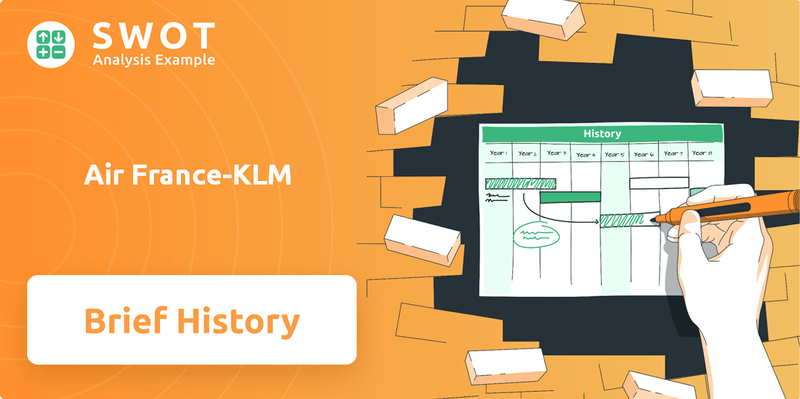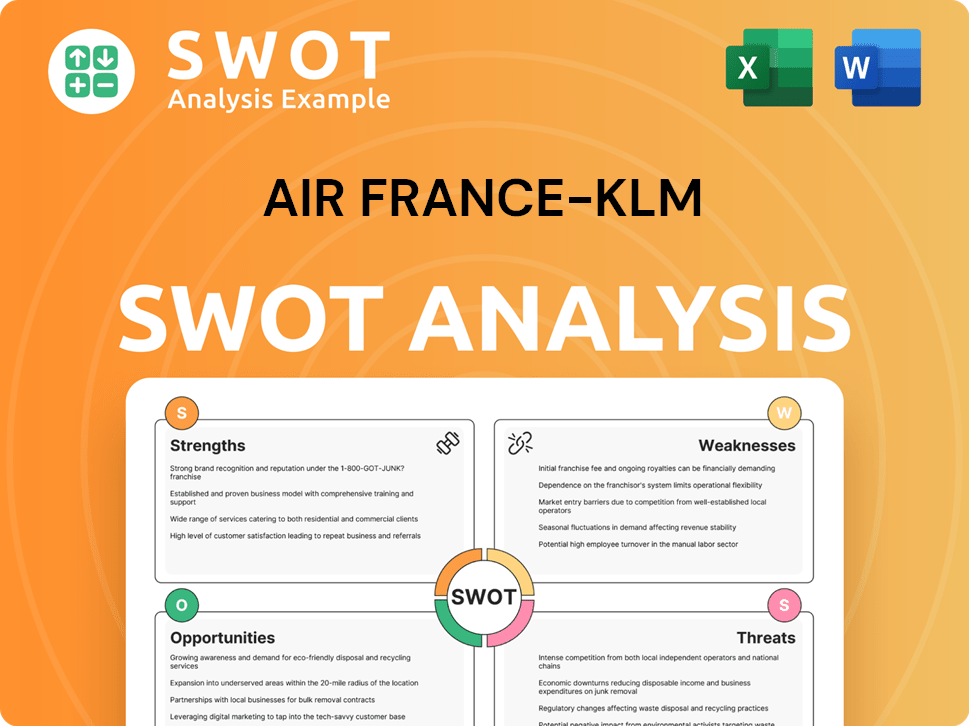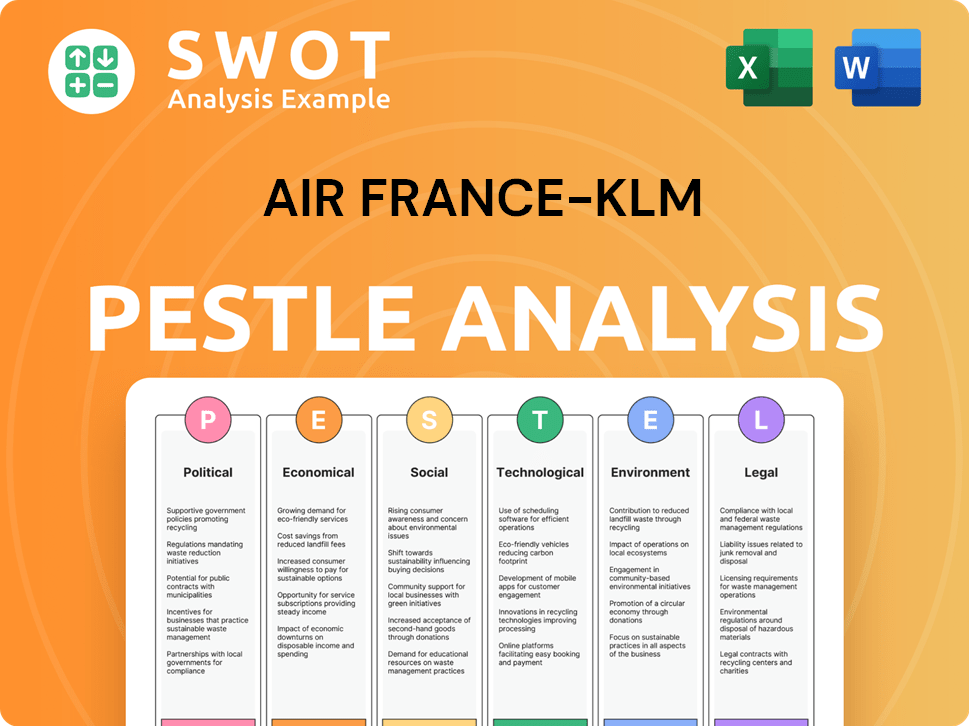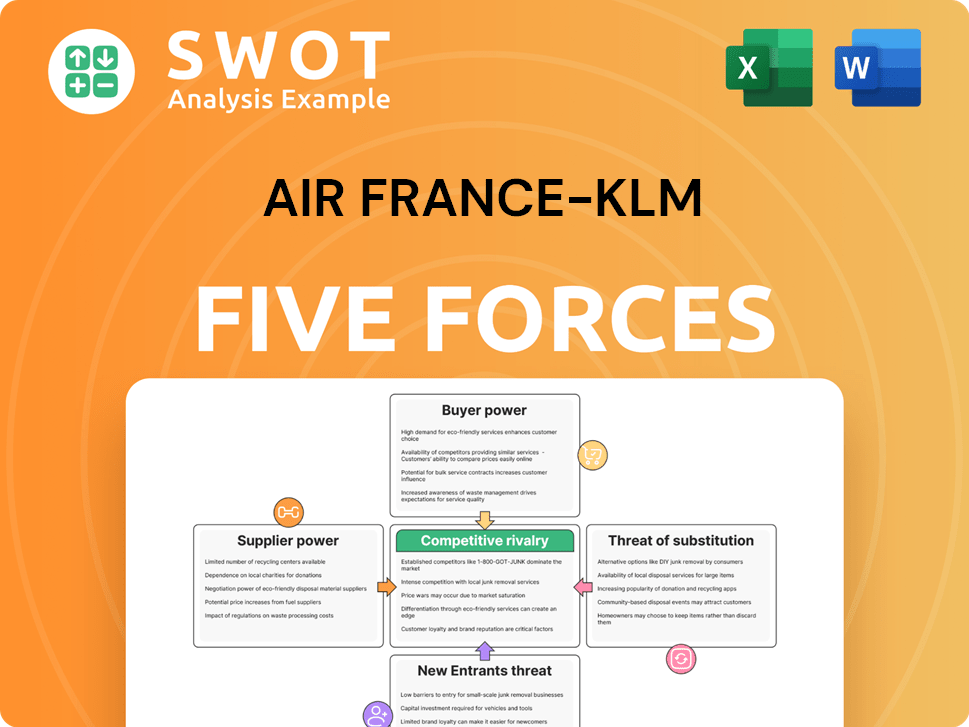Air France-KLM Bundle
How did Air France-KLM become a global aviation leader?
The story of Air France-KLM is a compelling narrative of strategic alliances and evolution within the dynamic aviation sector. From humble beginnings to a global powerhouse, this company's journey reflects the changing landscape of international travel and trade. Understanding the Air France-KLM SWOT Analysis is key to grasping its current market position.

Delving into the brief history of Air France and KLM reveals the roots of this Franco-Dutch airline giant. The Air France history and KLM history are intertwined, showcasing how these national carriers navigated the early days of flight and eventually merged. This exploration will detail the key milestones, from the founding of Air France in 1933 and KLM in 1919, to the pivotal airline merger that shaped European aviation.
What is the Air France-KLM Founding Story?
The story of Air France-KLM begins with the individual foundings of its two main airlines, each with its own rich history. This Mission, Vision & Core Values of Air France-KLM is a result of the merger of two well-established airlines, each bringing its unique legacy to the partnership.
KLM, or Koninklijke Luchtvaart Maatschappij (Royal Dutch Airlines), holds the distinction of being the world's oldest airline still operating under its original name. Air France, on the other hand, was created through the merger of several French airlines.
Understanding the origins of both Air France and KLM is key to grasping the full scope of the Air France-KLM story. Both airlines played crucial roles in shaping European aviation.
KLM was established on October 7, 1919, initiated by Dutch businessmen, including Albert Plesman, who became its first administrator.
- Plesman aimed to connect the Netherlands with its colonies and other European cities.
- The airline initially focused on connecting Amsterdam with London and other major European capitals.
- KLM received its royal designation from Queen Wilhelmina shortly after its founding.
- Funding came from private investors and government support.
Air France was founded on October 7, 1933, through the merger of five French airlines.
- The French government aimed to create a strong national airline.
- The merger addressed the fragmented nature of French air transport.
- Air France provided passenger, cargo, and postal services across a broad network.
- Early challenges included economic conditions and technological limitations.
Air France-KLM SWOT Analysis
- Complete SWOT Breakdown
- Fully Customizable
- Editable in Excel & Word
- Professional Formatting
- Investor-Ready Format

What Drove the Early Growth of Air France-KLM?
The early growth and expansion of both Air France and KLM were pivotal in shaping their legacies within the European aviation landscape. KLM's pioneering spirit and strategic route development, particularly to the Dutch East Indies, were key to its early success. Air France, after its consolidation, focused on building a cohesive national carrier, expanding across Europe, Africa, and French colonial territories. These early efforts laid the groundwork for their eventual merger.
In the 1920s and 1930s, KLM rapidly developed intercontinental routes, notably to the Dutch East Indies (now Indonesia). These long-haul flights, often with multiple stops, solidified KLM's reputation for innovation and reliability. Early aircraft like the Fokker F.VII were crucial for this expansion. KLM also established a global network of offices to support its growing operations. This expansion was critical for KLM's early financial performance and market presence.
Following its 1933 consolidation, Air France integrated its components into a national carrier. It expanded across Europe, Africa, and French colonial territories, mirroring the strategic importance of air links for colonial administration and trade. Air France invested heavily in maintenance facilities and personnel training, recognizing operational excellence's importance. This focus on infrastructure and personnel was vital for its long-term success.
Post-World War II, both airlines experienced significant growth due to increased air travel demand. They introduced larger, more advanced aircraft like the Lockheed Constellation and Boeing 707, enabling faster long-haul flights. The 1950s and 1960s saw further network expansion, with routes to North and South America and Asia. This period marked initial team expansions to support the growing fleet and network. This period was marked by a boom in passenger numbers and route expansions.
These early growth efforts laid the foundation for the eventual Air France-KLM merger. This merger demonstrated their individual strengths and market reach, setting the stage for their future as a combined entity. The strategic decisions and investments during this period were critical for shaping the future of both airlines. To understand the target market of Air France-KLM, consider reading this article: Target Market of Air France-KLM.
Air France-KLM PESTLE Analysis
- Covers All 6 PESTLE Categories
- No Research Needed – Save Hours of Work
- Built by Experts, Trusted by Consultants
- Instant Download, Ready to Use
- 100% Editable, Fully Customizable

What are the key Milestones in Air France-KLM history?
The story of Air France-KLM is a narrative of pioneering achievements, strategic adaptations, and resilience in the face of adversity. Both Air France history and KLM history are marked by significant milestones that have shaped the landscape of European aviation and beyond.
| Year | Milestone |
|---|---|
| 1919 | Air France's origins can be traced back to the founding of Compagnie des Messageries Aériennes, a precursor to the airline. |
| 1919 | KLM, the world's oldest airline still operating under its original name, was established. |
| 1924 | KLM initiated the first scheduled intercontinental service, flying to the Dutch East Indies. |
| 1946 | Air France began operating transatlantic flights, connecting Europe and North America. |
| 1976 | Air France commenced Concorde supersonic flights, revolutionizing transatlantic travel. |
| 2004 | The Air France-KLM merger took place, creating a major European aviation group. |
| 2020 | The COVID-19 pandemic caused unprecedented disruption, leading to significant restructuring. |
| 2024 | Air France-KLM continues to adapt to the changing aviation landscape, focusing on sustainability and operational efficiency. |
Innovations within Air France-KLM have consistently pushed the boundaries of air travel. Both airlines were early adopters of jet aircraft, which drastically reduced travel times and expanded their global reach. Passenger experience has also been a focus, with continuous improvements in in-flight services and comfort to enhance the overall travel experience.
The introduction of jet aircraft by both Air France and KLM significantly reduced flight times, making long-distance travel more accessible and efficient. This technological advancement helped to expand their route networks and increase passenger capacity.
Air France's operation of the Concorde represented a major innovation in aviation, offering transatlantic flights at speeds that were previously unimaginable. This service was a symbol of technological advancement and luxury travel.
Continuous advancements in in-flight services, including enhanced meal options, entertainment systems, and cabin comfort, have improved the passenger experience. These improvements have helped to maintain competitiveness in the industry.
Air France-KLM has invested in fleet modernization, incorporating fuel-efficient aircraft to reduce operational costs and environmental impact. This includes the introduction of newer aircraft models that offer improved fuel efficiency and reduced emissions.
The group continuously optimizes its route network to improve efficiency and profitability. This involves strategic adjustments to flight schedules and destinations to meet changing market demands and enhance connectivity.
Air France-KLM is actively pursuing sustainability initiatives, including the use of sustainable aviation fuels (SAF) and other measures to reduce its carbon footprint. The goal is to reduce CO2 emissions per passenger-kilometer by 30% by 2030 compared to 2019 levels.
The journey of Air France-KLM has been marked by significant challenges. Economic downturns, such as the oil crises and the 2008 financial crisis, have impacted the airline's financial performance. Competitive pressures from low-cost carriers have forced strategic re-evaluations and cost-cutting measures.
Economic crises, including the oil crises of the 1970s and the 2008 financial crisis, have significantly impacted air travel demand and profitability. These events often lead to reduced passenger numbers and revenue.
The rise of low-cost carriers has intensified competition, forcing Air France-KLM to adapt its strategies and reduce costs. This includes adjustments to pricing, route networks, and operational efficiencies.
Operational issues, such as strikes and air traffic control problems, have disrupted flights and impacted the airline's performance. These challenges can lead to delays, cancellations, and increased operational costs.
The merger of Air France and KLM in 2004 presented complex integration challenges, including cultural differences and the harmonization of IT systems. Successfully integrating two major airlines requires significant effort and resources.
The COVID-19 pandemic, starting in early 2020, caused an unprecedented crisis, leading to massive reductions in flights and revenue. This necessitated significant government support and restructuring efforts to ensure survival.
In 2024, Air France-KLM continues to navigate the challenges of the aviation industry, with ongoing efforts to improve financial performance and adapt to changing market conditions. The airline group focuses on fleet modernization and route network optimization.
Air France-KLM Business Model Canvas
- Complete 9-Block Business Model Canvas
- Effortlessly Communicate Your Business Strategy
- Investor-Ready BMC Format
- 100% Editable and Customizable
- Clear and Structured Layout

What is the Timeline of Key Events for Air France-KLM?
The Air France-KLM story is a significant chapter in the history of European aviation. The Air France history and KLM history are intertwined, marked by strategic decisions and pivotal moments. From KLM's early intercontinental flights to the formation of Air France and the eventual airline merger, the group has navigated numerous challenges and celebrated remarkable achievements. The evolution of the group reflects the dynamic shifts in the European aviation landscape and the global airline industry.
| Year | Key Event |
|---|---|
| 1919 | KLM founded in the Netherlands, marking the beginning of one of the world's oldest airlines. |
| 1924 | KLM launches its first scheduled intercontinental flight, connecting Amsterdam to Jakarta. |
| 1933 | Air France is created through the merger of five French airlines, consolidating French aviation. |
| 1946 | Air France initiates the first commercial transatlantic flight to New York, expanding its global reach. |
| 1960s | Both airlines expand their international networks rapidly with the introduction of jet aircraft. |
| 1976 | Air France begins commercial supersonic flights with the Concorde, showcasing technological advancements. |
| 2004 | Air France and KLM merge, forming the Air France-KLM Group, a major step in European aviation consolidation. |
| 2007 | The Flying Blue frequent flyer program is launched, enhancing customer loyalty and engagement. |
| 2012 | Air France-KLM joins the SkyTeam alliance, expanding its global network and partnerships. |
| 2020 | The COVID-19 pandemic severely impacts global aviation, leading to substantial government aid for Air France-KLM. |
| 2023 | Air France-KLM reports a record operating profit of 1.7 billion euros and a net profit of 0.9 billion euros, demonstrating a strong recovery. |
| 2024 | Air France-KLM continues fleet renewal and focuses on sustainability initiatives, targeting significant CO2 emission reductions by 2030. |
| 2025 | Continued recovery in long-haul travel is anticipated, with a sustained emphasis on premium segment growth. |
Air France-KLM is investing heavily in fleet renewal, replacing older aircraft with more fuel-efficient models like the Airbus A350 and Boeing 787. This strategy aims to reduce CO2 emissions per passenger-kilometer by 30% by 2030 compared to 2019. The group's commitment to sustainable aviation fuels (SAFs) and hydrogen propulsion will contribute to long-term environmental goals.
Digitalization and enhanced customer experience are key priorities. Air France-KLM continues to invest in online services and personalized offerings. This includes improvements to their mobile apps and websites, aiming to provide seamless travel experiences. The group is focused on leveraging data analytics to understand and meet customer needs.
The group is adapting to increasing demand for sustainable travel and continued growth in Asian markets. They are also navigating the evolving competitive landscape, including traditional and low-cost carriers. The group is well-positioned to capitalize on the anticipated recovery in international air travel, particularly in the premium segment. More information about the company can be found at Owners & Shareholders of Air France-KLM.
Analyst predictions suggest a continued recovery in international air travel, particularly in the premium segment, which Air France-KLM is well-positioned to capitalize on. Leadership emphasizes profitable growth, operational excellence, and a leading role in sustainable aviation. The group's focus is on achieving long-term financial stability and growth.
Air France-KLM Porter's Five Forces Analysis
- Covers All 5 Competitive Forces in Detail
- Structured for Consultants, Students, and Founders
- 100% Editable in Microsoft Word & Excel
- Instant Digital Download – Use Immediately
- Compatible with Mac & PC – Fully Unlocked

Related Blogs
- What is Competitive Landscape of Air France-KLM Company?
- What is Growth Strategy and Future Prospects of Air France-KLM Company?
- How Does Air France-KLM Company Work?
- What is Sales and Marketing Strategy of Air France-KLM Company?
- What is Brief History of Air France-KLM Company?
- Who Owns Air France-KLM Company?
- What is Customer Demographics and Target Market of Air France-KLM Company?
Disclaimer
All information, articles, and product details provided on this website are for general informational and educational purposes only. We do not claim any ownership over, nor do we intend to infringe upon, any trademarks, copyrights, logos, brand names, or other intellectual property mentioned or depicted on this site. Such intellectual property remains the property of its respective owners, and any references here are made solely for identification or informational purposes, without implying any affiliation, endorsement, or partnership.
We make no representations or warranties, express or implied, regarding the accuracy, completeness, or suitability of any content or products presented. Nothing on this website should be construed as legal, tax, investment, financial, medical, or other professional advice. In addition, no part of this site—including articles or product references—constitutes a solicitation, recommendation, endorsement, advertisement, or offer to buy or sell any securities, franchises, or other financial instruments, particularly in jurisdictions where such activity would be unlawful.
All content is of a general nature and may not address the specific circumstances of any individual or entity. It is not a substitute for professional advice or services. Any actions you take based on the information provided here are strictly at your own risk. You accept full responsibility for any decisions or outcomes arising from your use of this website and agree to release us from any liability in connection with your use of, or reliance upon, the content or products found herein.